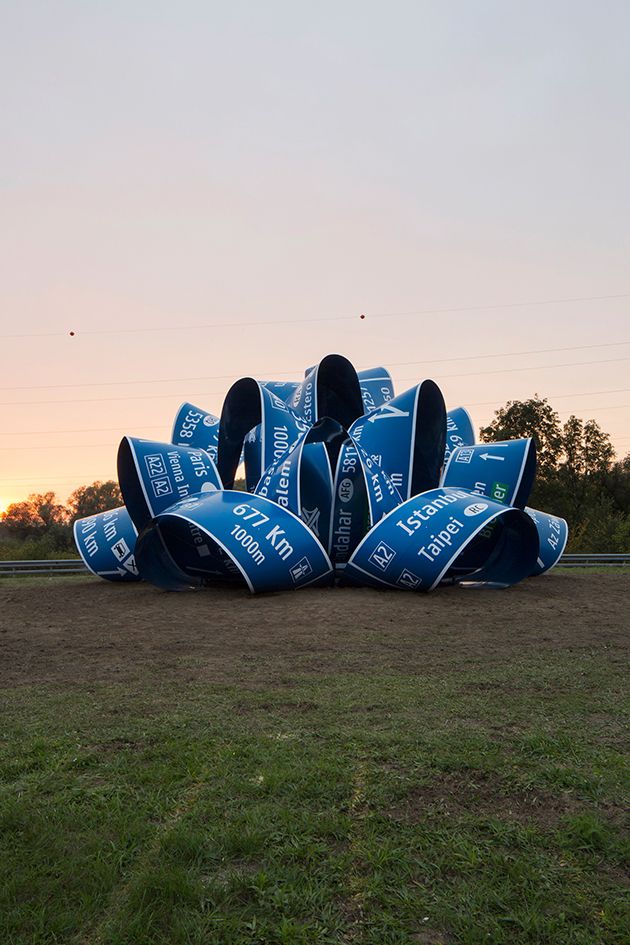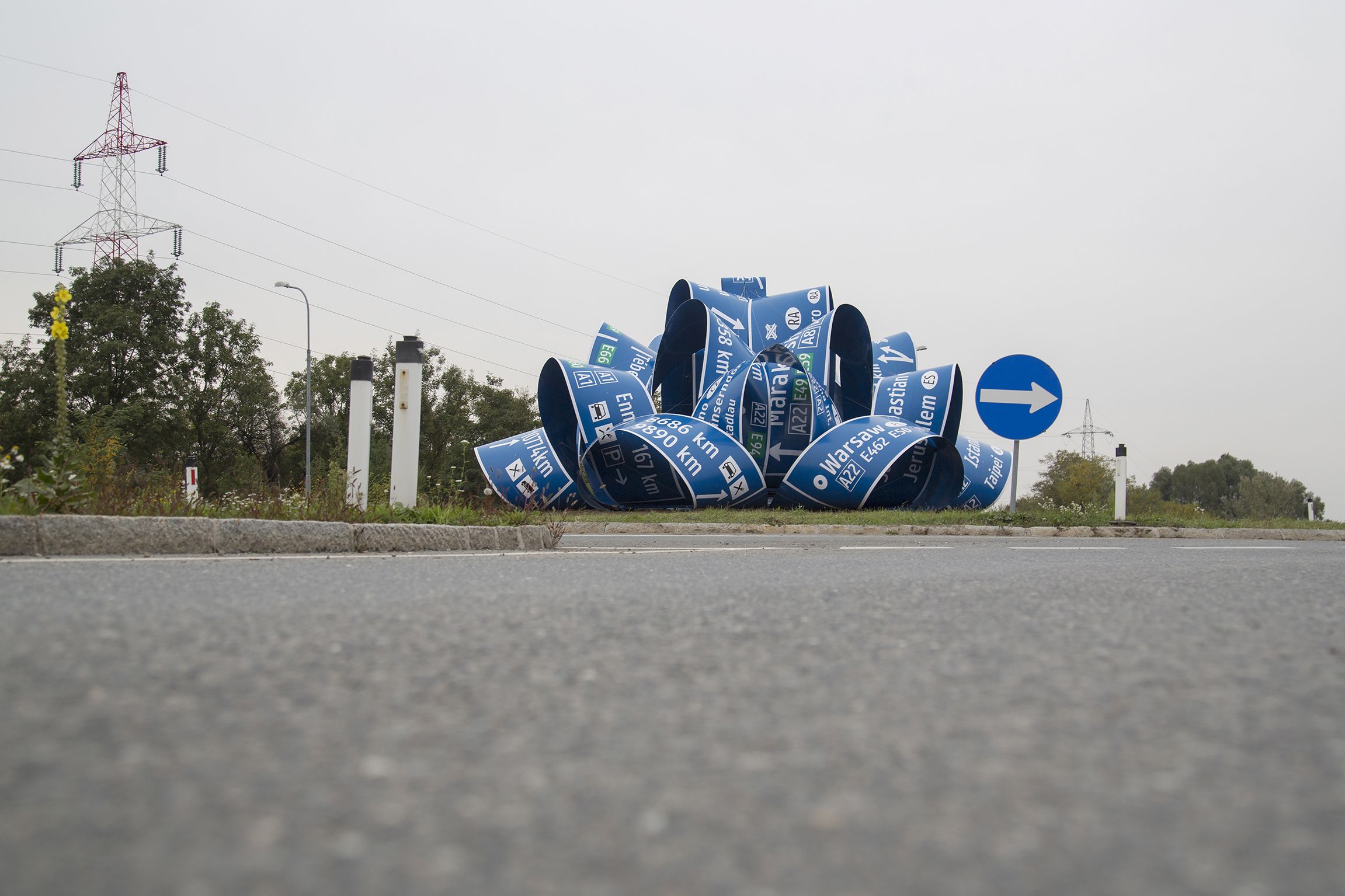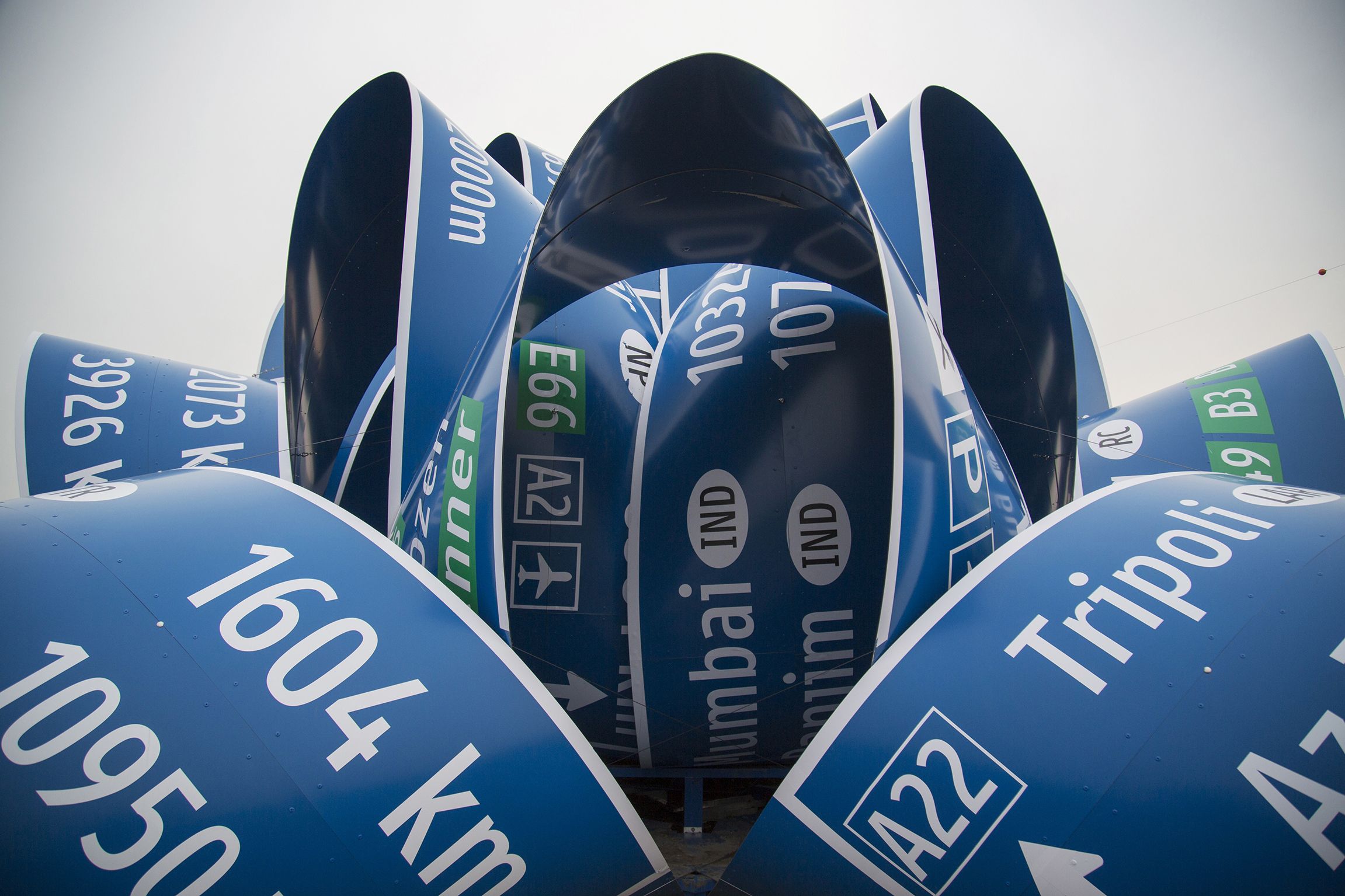Jitish Kallat
:
Here After Here After Here
Back
Information
At the traffic circle in Stockerau, the Indian artist Jitish Kallat bent and knotted highway signs into a gigantic bundle of endless loops. When turning into the roundabout, the signs first appear familiar, despite their being transformed into a sculpture. The color and writing make sense to us. It is only when we drive on that we begin to realize something is off, and a suspicion spreads like a visual Doppler effect. The signs do not point to neighboring towns or the next largest city, but to Marrakesh, Sidney, Warsaw, Mumbai, Caracas, and Los Angeles. The entire world seems to be assembled in this circle.
Not only is capital global, so is art. An artist from the Indian metropolis of Mumbai passing through Stockerau is therefore nothing unusual, because Jitish Kallat is a global artist. The venues where his exhibitions have been hosted so far read like an A-list of the most important art institutions: the Mori Art Museum in Tokyo, the Tate Modern and the Serpentine Gallery in London, the Martin Gropius Bau in Berlin, the Art Institute of Chicago, the Gwangju Biennale in South Korea, and the Asia Pacific Triennial in Australia. Meanwhile, here at Public Art Lower Austria we normally work with site-specific art. But what does site-specific mean in the 21st century? Is life in Stockerau really so different from life in Melbourne or Miami? Jitish Kallat visited Stockerau a few times. While here, he looked around, but he remained only a traveler passing through. He says what impressed him the most were the corridors of roads and the rhythm of noise barriers and road signs. Perhaps the colors and types of road signs are the only unique thing about these corridors along which goods and people circulate daily? Does being on the way to somewhere else not describe the essence of life in the region known as “10 vor Wien” (an area of 10 municipalities near Vienna), which includes Stockerau and nine other neighboring communities – an area where everyday life revolves around the many roundabouts on the way to work, to the shopping mall, and when driving the kids to a friend’s house or the soccer field?
Jitish Kallat once told me in a Skype conversation that he was sitting in front of his computer one day, looking at Stockerau in two Google Earth windows, exploring the context of this place from different distances. Suddenly, the roundabout he had zoomed in on was the same size as the Earth seen from space in the adjacent window. The entire world was a circle – it was a picture, a blueprint, and a symbol of a mandala all at the same time, representing the entire universe in its different geometries. The idea of a recursive loop, already apparent in the title of Kallat’s work Here After Here After Here, can be found in many cultures: in the endless knots of Buddhism, in alchemist diagrams, and of course in the mythical Ouroboros, the “self-devourer” that bites its own tail, is self-sufficient, and does not need any limbs to move forward because there is nothing outside itself. It also encircles itself eternally, creating the most perfect of all forms, the circle. The Ouroboros is a recurring theme in Jitish Kallat’s work. In Melbourne, he projected the YouTube buffering animation on the front side of a museum in the dead of night. This transfer of historical cultural knowledge to the present time is characteristic of his working method. At the traffic circle in Stockerau, he bent and knotted highway signs into a gigantic bundle of endless loops. When turning into the roundabout, the signs first appear familiar despite their being transformed into a sculpture. The color and writing make sense to us. It is only when we drive on that we begin to realize something is off, and a suspicion spreads like a visual Doppler effect. The signs do not point to neighboring towns or the next largest city. Instead, the entire world seems to be assembled in this circle: Marrakesh, Sidney, Warsaw, Mumbai, Caracas, Los Angeles. It is impossible to follow the twisted road signs and distances. Before we have figured it out, we are leaving the roundabout, and it remains a mystery.
"The street is my universe" said Jitish Kallat in an interview with Rajesh Punj for The Asia Art Newspaper in February 2010. The materials and images from the street life in his hometown of Mumbai can be found in many of his works, and he uses a similar method here in Lower Austria. Mythical traditions merge with omnipresent profane signs, like global aspects merge with local aspects, thus forming a work that seems to fit naturally in the center of a roundabout. A sculpture that is self-sufficient and yet communicates with us. We can look at it, read it, and experience it, and we can meditate on its after-image burned into our minds of how an artist from Mumbai has created a three-dimensional signpost that gracefully unites mystery and tongue-in-cheek humor in the no-man's-land of a roundabout in Lower Austria.
(Angelika Fitz)





